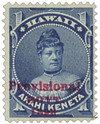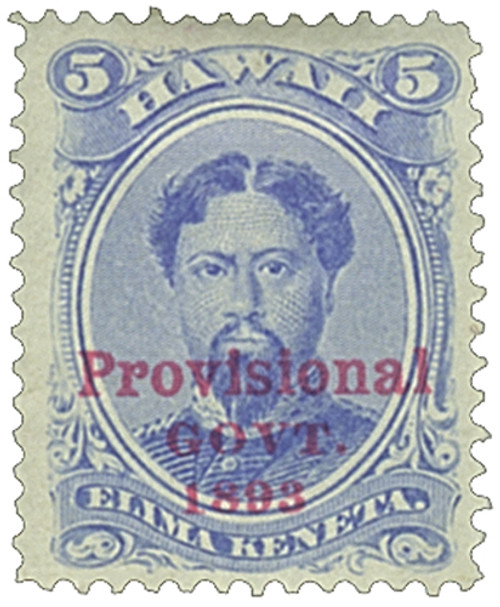
# H54 - 1893 1c Hawaii, blue, red overprint
The Provisional Government
Queen Liliuokalani took the throne at a turbulent time in Hawaii’s history. An economic depression was caused by the passage of the McKinley bill in the U.S. This bill made the price of Hawaiian sugar uncompetitive with sugar grown in the U.S. The sugar growers were very often prominent foreign businessmen, and they were often involved in the Hawaiian government for the specific purpose of protecting their own interests. Most of these businessmen favored annexation to the U.S. for economic reasons.
When the queen attempted to put her own constitution into effect, some businessmen formed an annexation club. This later became the Committee of Safety. The changes to her constitution were considered revolutionary. The most radical of these were: cabinet ministers were to serve “during the queen’s pleasure,” only male Hawaiian-born or naturalized subjects were allowed to vote, and nobles were appointed for life by the queen. If this constitution had passed, the queen would have almost total control over the political affairs of the country, and the legislators’ powers would be severely limited. Haoles, or white men, had become accustomed to running the Hawaiian government under the previous sovereigns.
The queen’s actions caused a panic among the businessmen in the community. The Committee of Safety was formed, mainly made up of annexationists opposing the queen. The Committee of Safety determined that the queen’s actions were a detriment to society, and called upon the United States for assistance in securing the public well-being.
Members of the committee obtained U.S. authority to set up a provisional government, and they wasted no time in doing so. A U.S. ship called the Boston was in Honolulu’s harbor at the time. Troops from the Boston took possession of the government office building, the Aliiolani Hale, on January 17, 1892. The provisional government was in place the next day.
On May 20, 1893, the stamps of the Kingdom of Hawaii went on sale with the overprint of “Provisional GOVT. 1893.” The newly appointed Postmaster General was Joseph M. Oat. Oat’s predecessor, Walter Hill, was ousted from his position. Overprinting of the stamps was done with great haste by the Hawaiian Gazette Co. There was a strong demand for the overprinted stamps, and the 2¢ bright vermillion sold out on the first day it was placed on sale.
The Provisional Government
Queen Liliuokalani took the throne at a turbulent time in Hawaii’s history. An economic depression was caused by the passage of the McKinley bill in the U.S. This bill made the price of Hawaiian sugar uncompetitive with sugar grown in the U.S. The sugar growers were very often prominent foreign businessmen, and they were often involved in the Hawaiian government for the specific purpose of protecting their own interests. Most of these businessmen favored annexation to the U.S. for economic reasons.
When the queen attempted to put her own constitution into effect, some businessmen formed an annexation club. This later became the Committee of Safety. The changes to her constitution were considered revolutionary. The most radical of these were: cabinet ministers were to serve “during the queen’s pleasure,” only male Hawaiian-born or naturalized subjects were allowed to vote, and nobles were appointed for life by the queen. If this constitution had passed, the queen would have almost total control over the political affairs of the country, and the legislators’ powers would be severely limited. Haoles, or white men, had become accustomed to running the Hawaiian government under the previous sovereigns.
The queen’s actions caused a panic among the businessmen in the community. The Committee of Safety was formed, mainly made up of annexationists opposing the queen. The Committee of Safety determined that the queen’s actions were a detriment to society, and called upon the United States for assistance in securing the public well-being.
Members of the committee obtained U.S. authority to set up a provisional government, and they wasted no time in doing so. A U.S. ship called the Boston was in Honolulu’s harbor at the time. Troops from the Boston took possession of the government office building, the Aliiolani Hale, on January 17, 1892. The provisional government was in place the next day.
On May 20, 1893, the stamps of the Kingdom of Hawaii went on sale with the overprint of “Provisional GOVT. 1893.” The newly appointed Postmaster General was Joseph M. Oat. Oat’s predecessor, Walter Hill, was ousted from his position. Overprinting of the stamps was done with great haste by the Hawaiian Gazette Co. There was a strong demand for the overprinted stamps, and the 2¢ bright vermillion sold out on the first day it was placed on sale.









